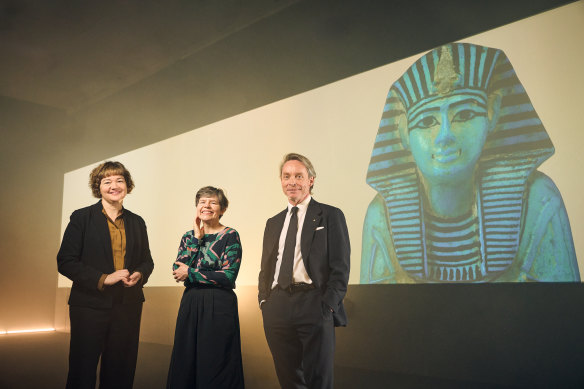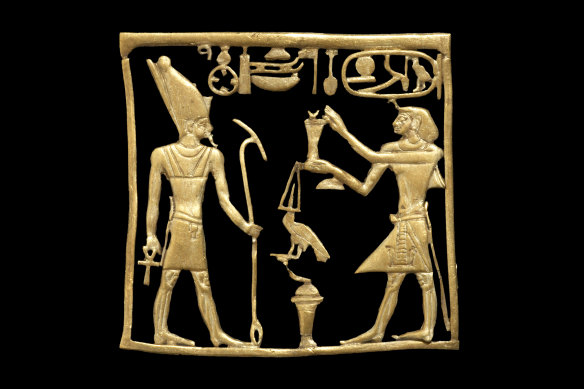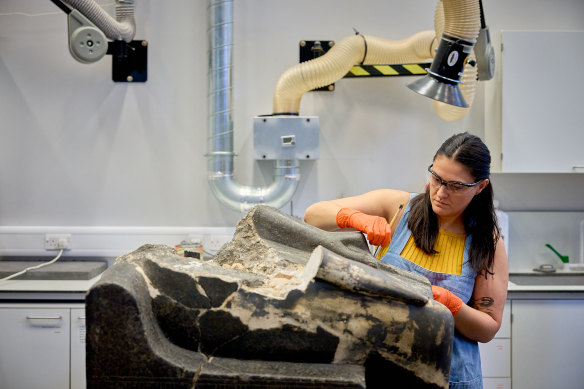This was published 1 year ago
Melbourne scores biggest ever British Museum collection for blockbuster new show
In the largest loan ever made by the British Museum, the NGV will stage Pharaoh, an exhibition made up of over 550 artefacts ranging from delicate works of jewellery to the wall of a tomb.
Pharaoh will take over the entire ground floor of the gallery in 2024, with many of the pieces having never been seen before. The items have been selected carefully to help see who an individual Pharaoh was through the imagery surrounding them.

NGV director Tony Ellwood (right) with senior curators Amanda Dunsmore (centre) and Dr Miranda Wallace.Credit: Eugene Hyland
Conversations about the exhibition started between the British Museum and NGV more than six years ago, with the driving idea being “to explore Ancient Egypt through their most iconic figure, which is the Pharaoh. But that’s really the entry point,” says Dr Marie Vandenbeusch, curator of funerary culture of the Nile valley at the British Museum’s Department of Egypt and Sudan.
It isn’t just about unpicking who the leaders were and what role they played in their society – “it’s also to tell the stories of all those peoples who actually were at the core of the ancient Egyptian civilisation,” she says.
“You have objects that are absolutely fascinating, but that have never been really displayed either in the galleries here, or in loans or in travelling exhibitions.”
Why is Ancient Egypt such an enduring source of fascination? “I think if you would ask any Egyptologist, they would give you a different answer,” says Vandenbeusch with a laugh.

Plaque of Amenemhat IV, probably Byblos, Lebanon 12th dynasty, reign of Amenemhat IV, about 1808-1799 BC. Credit: The Trustees of the British Museum
For her, it’s about the level of preservation that Egypt offers. More artefacts have survived in good condition than for any other ancient civilisation, offering a window into what society and daily life was really like, “which allows you to really relate in a couple of different ways to ancient people”.
The scale of the exhibition ranges from objects only a few centimetres wide to architectural installations and restored sculptures – including 10 statues of the goddess Sekhmet. “It’s quite fascinating because those statues were part of a much, much larger group of we think of around 730 statues,” says Vandenbeusch. “They’re all fascinating because they’re all very different from one another, they look very similar, but when you start looking in detail, you can see that they were all produced by different people with different types of style.”
Many of the artefacts require conservation before heading over to Melbourne. More than 3000 hours of conservation has already gone into the pieces selected for the exhibition, with 680 hours going into the statues of Sekhmet.
“But 450 of that has just been two of the sculptures,” explains Stephanie Vasiliou, senior conservator of stone, wall paintings and mosaics at the British Museum.

Stephanie Vasiliou, the British Museum’s senior conservator of stone, wall paintings and mosaics.Credit: Josh Caius
Each item has specific needs, which means the team has had to take creative and individual approaches – in one case laser cleaning has been used. “It works very similarly to tattoo removal,” explains Vasiliou.
They’ve also been steam-cleaning, using different solvents, and in the case of the Old Kingdom mastaba tomb, they used a combination of soft brushes, vacuum cleaners and conservation sponges. “[It’s been] quite a big undertaking,” she says, highlighting that this is just the work being done on stone objects.
Many pieces in the British Museum are contested, with requests in place for individual items and remains to be returned to their place of origin. In 2022, a petition for the Egyptian government to request the museum return the Rosetta Stone – which helped unlock understanding of Egyptian hieroglyphs – gained traction online, but the museum still holds it. From Australia, local groups have called for the return of a Gweagal shield, and the skulls of two Torres Strait Islander people. The Age has been told that none of the pieces in Pharaoh are contested.
Creating Pharaoh has been a labour of love for many people. “Because of this partnership we managed to create something which is quite unique and bespoke for National Gallery Victoria. This exhibition is not going to be seen anywhere else – it’s just going to be shown in Melbourne,” says Vandenbeusch. “It took years, but we got there”.
Pharaoh will be on display from June 14 to October 16, 2024 at NGV International.
The Booklist is a weekly newsletter for book lovers from books editor Jason Steger. Get it every Friday.